Kentucky is home to diverse birds, ranging from common backyard varieties to rare species. With over 400 species of birds recorded in Kentucky, the state boasts a wide variety of habitats and climates, making it an ideal location for birdwatchers.
Kentucky is a great place to observe various birds in their natural environment, from shorebirds along the coast to waterfowl in the wetlands to raptors soaring high above.
Whether you are a beginner birdwatcher or an experienced ornithologist, you will find something special in the skies of Kentucky.
48 Birds Of Kentucky
In the eastern United States, Kentucky boasts a rich avian tapestry that enchants both seasoned birdwatchers and casual nature enthusiasts alike.
With its rolling hills, expansive forests, meandering rivers, and vibrant wetlands, the Bluegrass State provides a haven for a remarkable variety of bird species.
Here are 48 Birds Of Kentucky.
1. Northern Cardinal
The Northern Cardinal is a beautiful bird, easily identified by its bright red plumage. It can be found in the eastern United States from Maine to Minnesota and south through Mexico and Belize.
Along with its striking coloration, it has a distinctive crest on its head and sharp black facial markings around the eyes.
Despite their small size (7-9 inches), they are very vocal birds – males sing persistently throughout springtime to attract mates or proclaim their territory.
They typically feed on insects, seeds, and fruits but enjoy suet at backyard bird feeders.
The female is less brightly colored than her mate but still stands out among other songbirds due to her warm brownish-red feathers.
Cardinals pair for life, so you may often see them together in your garden or neighborhood park.
Scientific classification:
| Kingdom | Animalia |
| Phylum | Chordata |
| Class | Aves |
| Order | Passeriformes |
| Family | Cardinalidae |
| Genus | C. cardinals |
| Species | C. cardinalis |
2. American Robin

The American robin is a migratory bird, belonging to the valid thrush genus and Turdidae family.
It was named after its European counterpart due to the similar reddish-orange breast they possess; however, they are not closely related.
This species can be seen through most of North America during winter and in parts of Mexico and Central America, where it also breeds.
They have plump bodies with gray upperparts and white underparts that vary from yellow on their throats down to orange toward their bellies.
Robins feed on fruits such as berries or insects like worms, making them an essential part of ecosystems by helping disperse seeds naturally throughout these areas.
Scientific classification:
| Kingdom | Animalia |
| Phylum | Chordata |
| Class | Aves |
| Order | Passeriformes |
| Family | Turdidae |
| Genus | Turdus |
| Species | T. migratorius |
3. American Goldfinch
The American goldfinch is a small North American bird in the finch family. Males are vibrant yellow with black wings and tails, while females are duller in coloration.
It migrates from mid-Alberta to North Carolina during the breeding season, south of Canada–United States border to Mexico for its wintering grounds.
The only finch that undergoes complete molt every year displays sexual dichromatism, where males have brighter colors than their female counterparts.
They feed mainly on seeds but also eat insects such as aphids and caterpillars when raising young; they often occur near thistles or other plants that produce viable seed heads.
Their call consists of various chirps and trills, making them quite conspicuous.
Scientific classification:
| Kingdom | Animalia |
| Phylum | Chordata |
| Class | Aves |
| Order | Passeriformes |
| Family | Fringillidae |
| Subfamily | Carduelinae |
| Genus | Spinus |
| Species | S. tristis |
4. House Finch

The House Finch is a finch species native to western North America and has been introduced in the eastern half of the continent and Hawaii.
It’s an average-sized finch with adults measuring 12.5 – 15 cm (5 – 6 inches) long and wingspan between 20 – 25 cm (8 – 10 inches).
The upperparts are brown, while its underparts range from pale grayish white to yellow depending on subspecies.
Its face is streaked or spotted with reddish coloration; males typically have brighter plumage than females due to sexual dimorphism.
They’re mostly found near human habitations such as farms and gardens, where they feed on grains, fruits, insects, etc., making them very popular among birders who want something colorful for their backyard.
Scientific classification:
| Kingdom | Animalia |
| Phylum | Chordata |
| Class | Aves |
| Order | Passeriformes |
| Family | Fringillidae |
| Subfamily | Carduelinae |
| Genus | Haemorhous |
| Species | H. mexicanus |
5. Mourning Dove
The Mourning Dove is a breathtakingly beautiful bird. It has stunning gray and brown feathers with white-tipped wings, giving it an elegant appearance. Its long tail also adds to its graceful look in flight.
A symbol of peace and serenity, they are abundant across North America and can be found in gardens or open fields throughout the year.
As well as being popular game birds for hunters, they feed on grains such as wheat and millet, providing essential food sources for wildlife species, including foxes, coyotes, skunks, and raccoons.
These doves have a distinctive cooing sound that can often echo through woodlands during summer evenings, making them one of nature’s greatest treasures.
Scientific classification:
| Kingdom | Animalia |
| Phylum | Chordata |
| Class | Aves |
| Order | Columbiformes |
| Family | Columbidae |
| Genus | Zenaida |
| Species | Z. macroura |
6. Common Starling

The Common Starling is a medium-sized passerine bird that belongs to the Starling family. It has glossy black plumage with a metallic sheen and can be sprinkled with w at certain times.
The bill and legs are typically pink or black depending on the season, while its length measures about 8 inches long.
Its diet consists mainly of insects but includes small fruits, seeds, and human food waste.
They live in large flocks, which protects predators, although they can become quite aggressive when defending their nesting sites during breeding seasons.
Overall, this species is highly adaptable and widely distributed across many parts of Europe, making them one of the most successful birds in the region today.
Scientific classification:
| Kingdom | Animalia |
| Phylum | Chordata |
| Class | Aves |
| Order | Passeriformes |
| Family | Sturnidae |
| Genus | Sturnus |
| Species | S. vulgaris |
7. Carolina Chickadee
The Carolina Chickadee is a small passerine bird found in the tit family Paridae. It stands out for its distinct black and white, grey-brown feathers with an off-white underside.
This species can be spotted by its call: “chick-a-dee.” The American Ornithologists’ Union has classified them into their genus called Poecile, as they differ from other tits due to both genetic data and morphology.
These birds live in wooded areas near open fields or water sources all over North America.
They feed on insects such as caterpillars but have also been known to eat suet at backyard feeders during winter when food is scarce.
Scientific classification:
| Kingdom | Animalia |
| Phylum | Chordata |
| Class | Aves |
| Order | Passeriformes |
| Family | Paridae |
| Genus | Poecile |
| Species | P. carolinensis |
8. Blue Jay
The Blue Jay is a beautiful bird in the eastern and central United States and Newfoundland, Canada.
They have an unmistakable blue plumage with white markings on their heads and wings.
These birds are highly adaptable to habitats ranging from deciduous forests to urban areas.
As part of the Corvidae family, they are known for being intelligent problem solvers who often use tools or mimic vocalizations of other species, like hawks, when defending their territories.
Their diet consists mainly of insects, seeds, and nuts but can also include small vertebrates such as frogs or lizards if food resources become scarce.
Overall, these birds provide much-needed color to our environment while playing essential roles in maintaining healthy ecosystems through pollination services and seed dispersal activities.
Scientific classification:
| Kingdom | Animalia |
| Phylum | Chordata |
| Class | Aves |
| Order | Passeriformes |
| Family | Corvidae |
| Genus | Cyanocitta |
| Species | C. cristata |
9. Song Sparrow
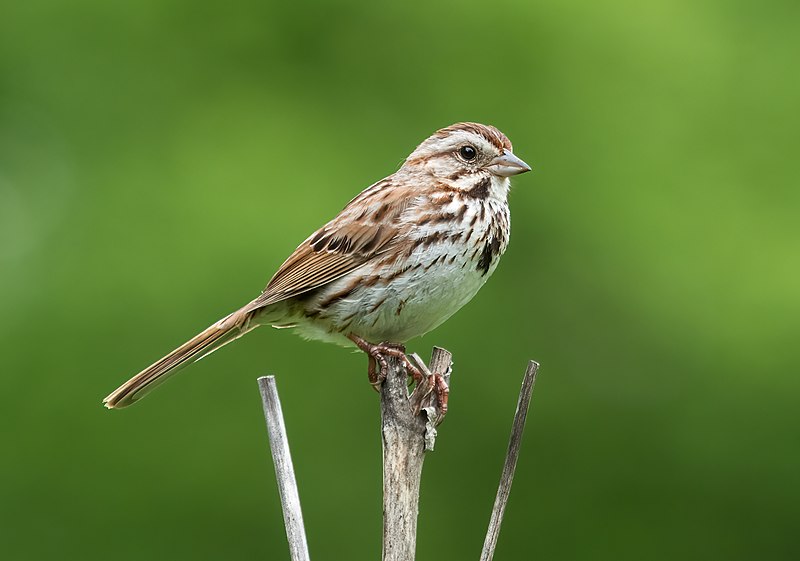
The Song Sparrow (Melospiza melodia) is a small yet abundant bird in North America.
They have brown upperparts with dark streaks and are white underneath, complete with a distinct dark brown spot on the breast.
Their cap is also brown, and long, rough feathers can be seen sprouting from their neck area.
This sparrow species is highly variable and adaptable to many environments, including dry brush land, wetlands, or open fields.
It has been noted that adult song sparrows will sing even during winter when other birds remain quiet.
These energetic little animals make great backyard companions as they sing their lovely melodies.
Scientific classification:
| Kingdom | Animalia |
| Phylum | Chordata |
| Class | Aves |
| Order | Passeriformes |
| Family | Passerellidae |
| Genus | Melospiza |
| Species | M. melodia |
10. Tufted Titmouse
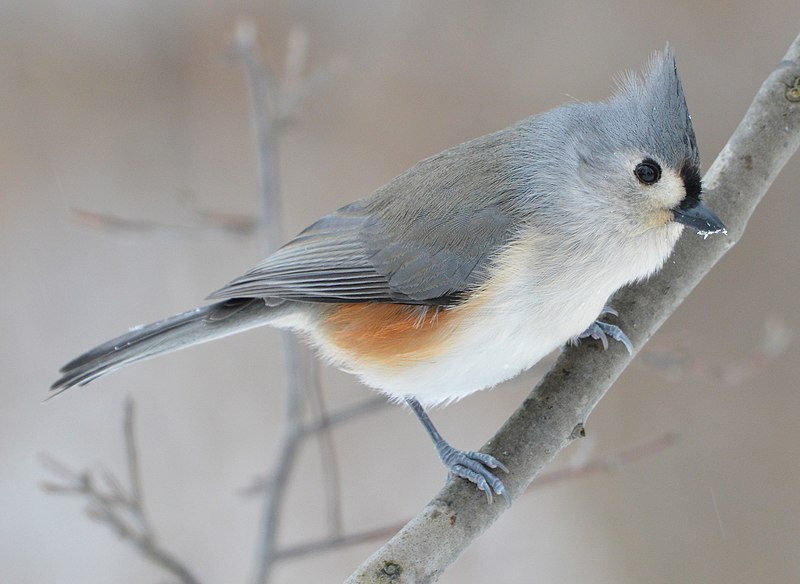
The Tufted Titmouse is a small, cheerful songbird found in North America. It’s part of the tit and chickadee family (Paridae).
It has distinctive white feathers around its eyes, grey-brown wings, and upper body, with a pale tan underside.
Its most notable feature is the black crest on top of its head, which gives it a curious look. The male also sports a pinkish breast, which can be seen.
When singing from high perches during the spring months. This bird loves to eat sunflower seeds or suet at backyard feeders and insects in summertime.
You may even see them poking into crevices and bark, looking for food.
They are exceptionally social birds, too, being often spotted in mixed flocks alongside other species, such as nuthatches and woodpeckers, all year round.
Scientific classification:
| Kingdom | Animalia |
| Phylum | Chordata |
| Class | Aves |
| Order | Passeriformes |
| Family | Paridae |
| Genus | Baeolophus |
| Species | B. bicolor |
11. Eastern Towhee
The Eastern Towhee is a large New World sparrow native to brushy areas of eastern North America. These birds have distinct black and white markings, with chestnut brown underparts.
They nest either low in bushes or on the ground beneath shrubs. Northern towhees are known for migrating south during the winter months.
In recent decades, taxonomy debates have left some questioning whether this bird should remain its species or be grouped with the Spotted Towhee as one species — Rufous-sided Towhee.
This lively songbird is bubbly and can often hop around on branches looking for food, such as insects, fruits, and seeds.
Scientific classification:
| Kingdom | Animalia |
| Phylum | Chordata |
| Class | Aves |
| Order | Passeriformes |
| Family | Passerellidae |
| Genus | Pipilo |
| Species | P. erythrophthalmus |
12. Northern Mockingbird
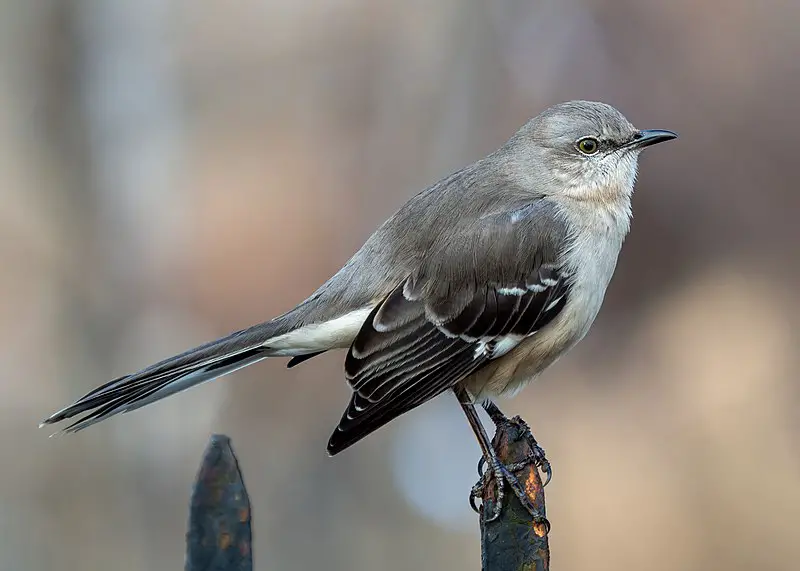
The northern mockingbird is a standard fixture in North American skies. It has greyish-brown upperparts and a paler underside with white wing patches, and its distinctive long tail makes it easy to spot.
This adaptable bird can often be seen singing from the tops of trees or fences, though it rarely strays into Europe.
Carl Linnaeus first described the species in his 1758 Systema Naturae as Turdus polyglottos – aptly named for their remarkable ability to mimic other birds’ songs.
Northern mockingbirds typically live on insects, fruits, berries, and seeds but will also happily scavenge food scraps left out by humans.
This beloved avian contributes to our environment with its beautiful song and striking plumage.
Scientific classification:
| Kingdom | Animalia |
| Phylum | Chordata |
| Class | Aves |
| Order | Passeriformes |
| Family | Mimidae |
| Genus | Mimus |
| Species | M. polyglottos |
13. White-Breasted Nuthatch
The White-breasted Nuthatch is a medium-sized bird belonging to the nuthatch family Sittidae. It measures around 15.5 cm long, and its color varies throughout its range.
Males have a light blue-grey upperpart, with a black crown and nape, whereas females have a dark grey crown instead of a black one.
The underparts are whitish, with a reddish tinge on the sides and flanks, while the bill is short and stout with a pale base near the eyes, which can be yellow or white depending on geographic location.
This species feeds mainly on insects but eats seeds, nuts, and berries when available.
They prefer open woodlands where they often climb trees searching for food along trunks and branches underneath bark crevices, creating their nest there, too.
Scientific classification:
| Kingdom | Animalia |
| Phylum | Chordata |
| Class | Aves |
| Order | Passeriformes |
| Family | Sittidae |
| Genus | Sitta |
| Species | S. carolinensis |
14. Eastern Bluebird
The Eastern bluebird is a small migratory thrush found in North America’s open woodlands, farms, and orchards.
The male has bright-blue breeding plumage, which makes it easily recognizable by birders.
It produces melodic songs such as Jeew, chair-wi, and Chili WEEW Widow.
This widespread species was declared the state bird of Missouri back in 1927 due to its beauty and charm.
In addition to being beautiful, these birds are also beneficial for farmers because they eat insects like grasshoppers and beetles, which damage crops.
They nest in cavities, so providing nesting boxes helps them thrive even more.
With their vibrant colors, sweet melodies, and helpful nature, it’s easy to see why the Eastern Bluebird is beloved worldwide.
Scientific classification:
| Kingdom | Animalia |
| Phylum | Chordata |
| Class | Aves |
| Order | Passeriformes |
| Family | Turdidae |
| Genus | Sialia |
| Species | S. sialis |
15. Red-bellied woodpecker
The Red-bellied woodpecker is a beautiful bird with an orange-red crown and nape. It breeds mainly in the eastern United States, from Florida to Canada.
This medium-sized woodpecker of the family Picidae has black wings, white stripes on its back, and tail feathers barred with black.
Its underside is primarily pale yellow or white but has some red coloration around its neck.
Despite this subtle red hue, it should not be mistaken for the entirely red head and neck belonging to the Red-headed woodpecker of the same genus, Melanerpes carolinus.
The Red-bellied Woodpeckers’ diet consists primarily of insects such as ants, beetles, grasshoppers, nuts, fruits, berries, and tree sap, which they feed upon at different times throughout their life cycle.
Scientific classification:
| Kingdom | Animalia |
| Phylum | Chordata |
| Class | Aves |
| Order | Piciformes |
| Family | Picidae |
| Genus | Melanerpes |
| Species | M. carolinus |
16. Downy Woodpecker
The downy woodpecker is a small species of woodpecker found in North America. Growing up to 7 inches long, it can be identified by its white belly and spotted wings.
It inhabits forests throughout the United States and Canada, except deserts in the southwest and northern tundra.
This bird nests in tree cavities and feeds mainly on insects but will supplement its diet with fruit or nuts when available.
The Downy Woodpecker has an unmistakable call that sounds like a loud ‘piker,’ similar to other members of its family, such as the Hairy Woodpecker.
Scientific classification:
| Kingdom | Animalia |
| Phylum | Chordata |
| Class | Aves |
| Order | Piciformes |
| Family | Picidae |
| Genus | Dryobates |
| Species | D. pubescens |
17. Brown-Headed Cowbird
The Brown-headed Cowbird is a small, obligate brood parasitic icterid native to temperate and subtropical North America. It has a brown head with glossy black plumage on the body, wings, and tail feathers.
During summer, they can be found in prairies, grassland, and open wooded areas, but during winter, they migrate southwards towards the United States of Mexico for warmer climates.
They are mainly insectivorous birds that eat and consume some grains of insects like caterpillars or beetles.
The female bird lays its eggs in nests of other species and then incubates them until hatching time, thus leaving their chicks uncared for.
Scientific classification:
| Kingdom | Animalia |
| Phylum | Chordata |
| Class | Aves |
| Order | Passeriformes |
| Family | Icteridae |
| Genus | Molothrus |
| Species | M. ater |
18. Kentucky Warbler
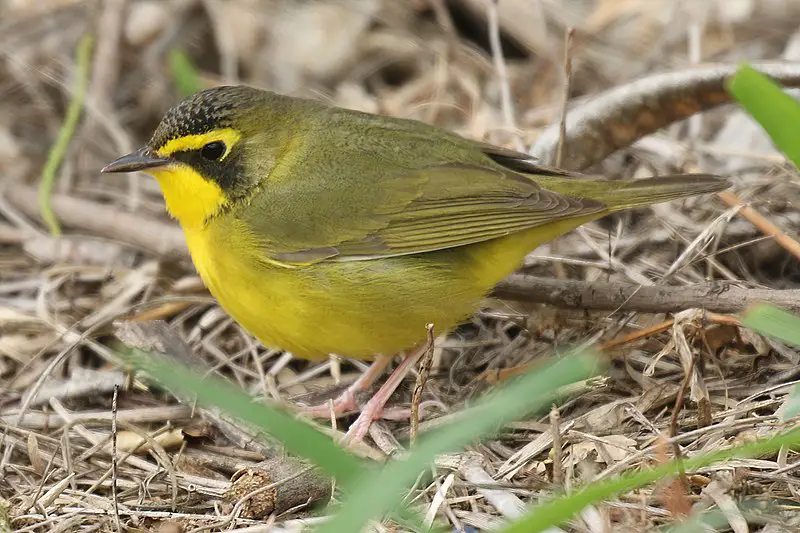
The Kentucky Warbler is a beautiful bird, with its olive-green back and brilliant yellow underside.
Its short tail and sluggish behavior distinguish it from other singers, as it prefers to stay on or near the ground rather than fly around like others.
These birds are native to North America and can be seen in deciduous woodlands searching for insects among leaf litter during summer.
They have a slight hint of black at their throats, which stands out against their vibrant coloring, making them stand out even more.
During breeding season, males sing loudly from high perches to court females, who will then build nests hidden away close to the ground and near sources of water such as streams or ponds where food supplies are plentiful for raising young chicks.
Scientific classification:
| Kingdom | Animalia |
| Phylum | Chordata |
| Class | Aves |
| Order | Passeriformes |
| Family | Parulidae |
| Genus | Geothlypis |
| Species | G. formosa |
Also Featured In: Birds in Iowa Spring, Caribbean Birds
19. Carolina Wren
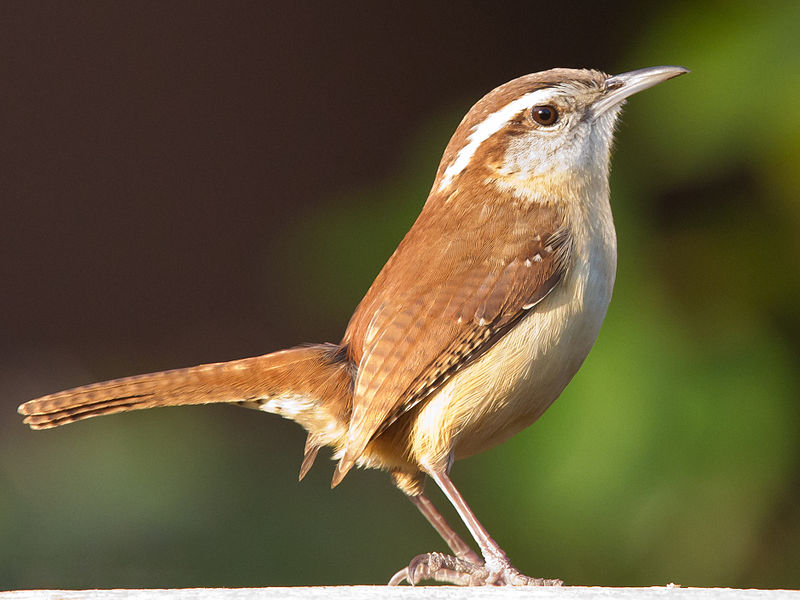
The Carolina wren (Thryothorus ludovicianus) is a medium-sized bird in the eastern United States, southern Ontario, and northeast Mexico.
They typically live in dense shrubbery or thickets near open areas such as gardens, parks, and woodland edges.
These birds are adaptable in nesting sites – they will build their nests anywhere from tree cavities to artificial boxes.
Their diet consists of insects, spiders, and other invertebrates, which they forage for on the ground or among vegetation.
The males have an unmistakable song of loud whistles interspersed with trills reminiscent of laughter; you’ll often find these cheerful little birds singing away during the early morning hours.
Scientific classification:
| Kingdom | Animalia |
| Phylum | Chordata |
| Class | Aves |
| Order | Passeriformes |
| Family | Troglodytidae |
| Genus | Thryothorus Vieillot, 1816[2] |
| Species | T. ludovicianus |
20. Common Yellowthroat
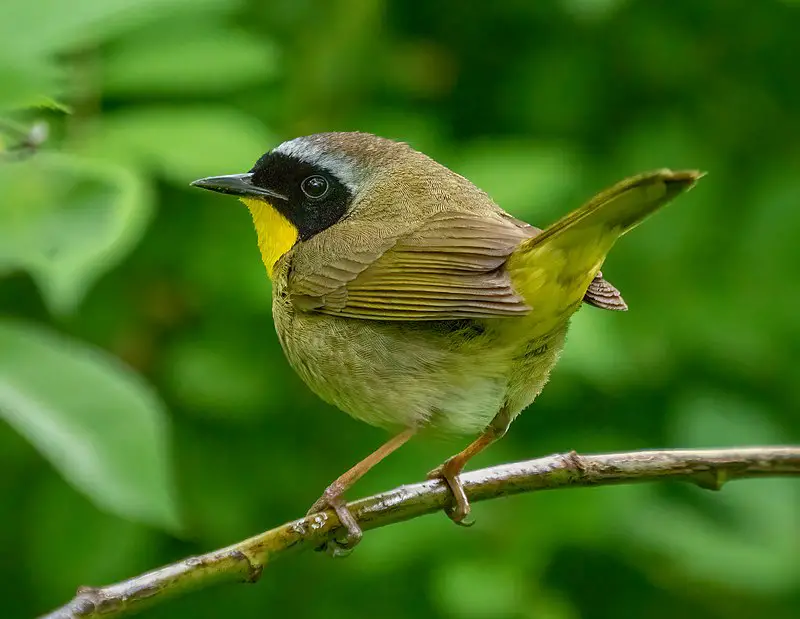
The Common Yellowthroat is a tiny New World Warbler found throughout North America. It has distinctive yellow and black plumage, earning it the nickname “Yellow Bandit” in the Midwest United States.
This highly adaptable species inhabits wetlands, grasslands, shrubland habitats, and suburban areas.
The genus of this bird’s scientific name means ‘ground’ and ‘small bird,’ which are fitting characteristics for such an elusive yet familiar little creature.
Its diet consists predominantly of insects but may also include other invertebrates like spiders or worms.
Overall, its cheerful song makes the Common Yellowthroat an excellent addition to any backyard.
Scientific classification:
| Kingdom | Animalia |
| Phylum | Chordata |
| Class | Aves |
| Order | Passeriformes |
| Family | Parulidae |
| Genus | Geothlypis |
| Species | G. trichas |
21. Red-Winged Blackbird

The red-winged blackbird is a beautiful bird found in most of North America and Central America.
Its distinct features include a glossy black body, white shoulder patches, and bright red wing coverts year round.
It prefers wetland habitats such as marshes, ponds, lakeshores, and agricultural fields. During breeding season, they inhabit grassy areas near water, then move south for the winter months.
For food, they mainly eat insects but also consume wild fruit or grains.
They are very social birds, often seen in large flocks during migration when their unmistakable “conk-la-ree” call can be heard echoing across the sky.
Scientific classification:
| Kingdom | Animalia |
| Phylum | Chordata |
| Class | Aves |
| Order | Passeriformes |
| Family | Icteridae |
| Genus | Agelaius |
| Species | A. phoeniceus |
22. Dark-Eyed Junco

The Dark-eyed Junco is a species of small, grayish sparrows found across much of temperate North America and in the Arctic during summer.
Carl Linnaeus formally described it in 1766 and named it after its distinctive dark eyes.
This bird has a very variable appearance due to the many different subspecies it contains, making its systematics challenging to unravel.
The plumage varies from white or light gray on their underparts with slate grey backs and wings, black heads with white outer tail feathers, brown head stripes, yellow bills, pink legs and feet, and various shades between all these colors.
They also have considerable sexual dimorphism; males tend to be more colorful than females but share similar characteristics such as short tails and rounded bodies – both sexes being around 16 cm long when fully grown.
Scientific classification:
| Kingdom | Animalia |
| Phylum | Chordata |
| Class | Aves |
| Order | Passeriformes |
| Family | Passerellidae |
| Genus | Junco |
| Species | J. hyemalis |
23. White-Throated Sparrow
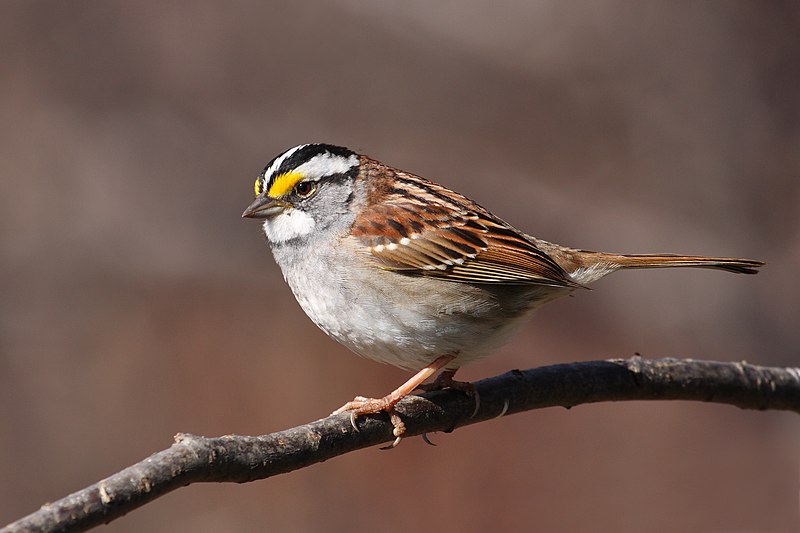
The White-throated Sparrow is a small passerine bird of the New World sparrow family, Passerellidae.
It has distinctive yellow and black stripes on its head, white throat and chest, grey back and wings, and light brown legs.
The scientific name “Zonotrichia albicollis” comes from Ancient Greek for ‘band’ (ζώνη), referring to its distinctive striped crown, and Latin for ‘white neck’ (albus collum).
These birds are usually found in wooded areas such as coniferous forests or deciduous habitats in North America, where they feed mainly on insects during the summer months, transitioning to seeds during winter.
They build their nests near ground level using grasses, twigs, or moss lined with feathers.
White-throated Sparrows may be solitary but also form flocks when migrating southward each fall season, which typically occurs over mid-late October through November, depending on location within range.
Scientific classification:
| Kingdom | Animalia |
| Phylum | Chordata |
| Class | Aves |
| Order | Passeriformes |
| Family | Passerellidae |
| Genus | Zonotrichia |
| Species | Z. albicollis |
24. Common Grackle
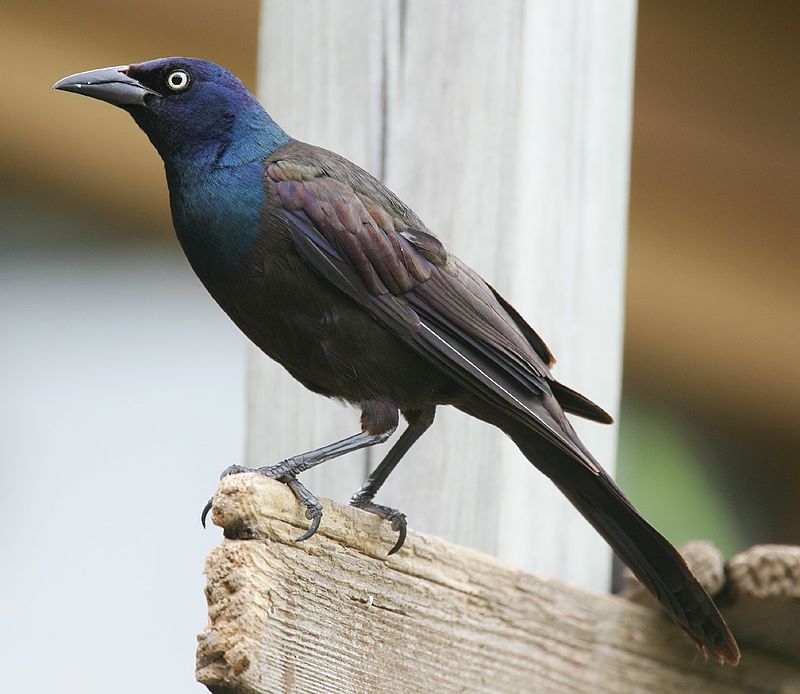
The Common Grackle is a large icterid bird commonly found in North America. It has an iridescent head and pale yellow eyes framed by its long dark bill and long tail.
Males typically have more vivid colors on their heads than females do. These birds can be seen across much of the continent, in fields, forests, wetlands – even urban areas.
They form considerable flocks to search for food, such as grains or insects, that they catch with their bills.
If available, the grackles may also scavenge from human sources like garbage dumps or picnic tables. With its colorful plumage and distinct call, it spottingasy amongst other birds.
Scientific classification:
| Kingdom | Animalia |
| Phylum | Chordata |
| Class | Aves |
| Order | Passeriformes |
| Family | Icteridae |
| Genus | Quiscalus |
| Species | Q. quiscula |
25. Pileated Woodpecker
The pileated woodpecker is a large, majestic bird native to North America.
Its striking black plumage and red crest make it an unmistakable sight in the forest canopy of deciduous forests across eastern North America, the Great Lakes region, Canada’s boreal forests, and parts of the Pacific Coast.
It is one of the largest woodpeckers in North America: larger than any other confirmed species except for perhaps its relative, the ivory-billed woodpecker.
Insectivorous by nature, this stunning creature can be seen pecking away at tree trunks, searching for food, or making nest cavities – all with remarkable skill.
The pileated woodpecker symbolizes beauty and resilience amongst our avian wildlife.
Scientific classification:
| Kingdom | Animalia |
| Phylum | Chordata |
| Class | Aves |
| Order | Piciformes |
| Family | Picidae |
| Genus | Dryocopus |
| Species | D. pileatus |
26. Ruby-Throated Hummingbird
The ruby-throated hummingbird (Archilochus colubris) is a hummingbird species with an impressive migration pattern, spending the winter in Central America, Mexico, and Florida before flying to Canada and other parts of Eastern North America for the breeding season.
It’s the most common type seen east of the Mississippi River in North America.
Formally described by Swedish naturalist Carl Linnaeus in 1758, this tiny bird has bright metallic green upperparts with white underparts, a small black bill, and a red throat patch, which gives it its name; they measure around 3 inches long on average.
They feed primarily on nectar from flowers but eat insects such as flies or mosquitoes for extra protein during their migrations or when raising young chicks.
Scientific classification:
| Kingdom | Animalia |
| Phylum | Chordata |
| Class | Aves |
| Order | Apodiformes |
| Family | Trochilidae |
| Genus | Archilochus |
| Species | A. colubris |
27. Indigo Bunting
The Indigo Bunting is a small bird in the cardinal family throughout North and South America.
It has an unmistakable bright blue plumage that stands out against its natural habitat of farmland, brush areas, and open woodland.
During the breeding season, it can be seen from southern Canada to northern Florida; during winter, it migrates south towards Central and Northern South America.
The Indigo Bunting prefers to migrate at night using the stars as navigation aids.
This species feeds on insects and seeds they find near the ground or catch mid-flight with their agile wingspan.
An iconic sight for many farmers across both continents, these birds are a welcome addition to any backyard oasis or wildflower meadow.
Scientific classification:
| Kingdom | Animalia |
| Phylum | Chordata |
| Class | Aves |
| Order | Passeriformes |
| Family | Cardinalidae |
| Genus | Passerina |
| Species | P. cyanea |
28. Red-Headed Woodpecker
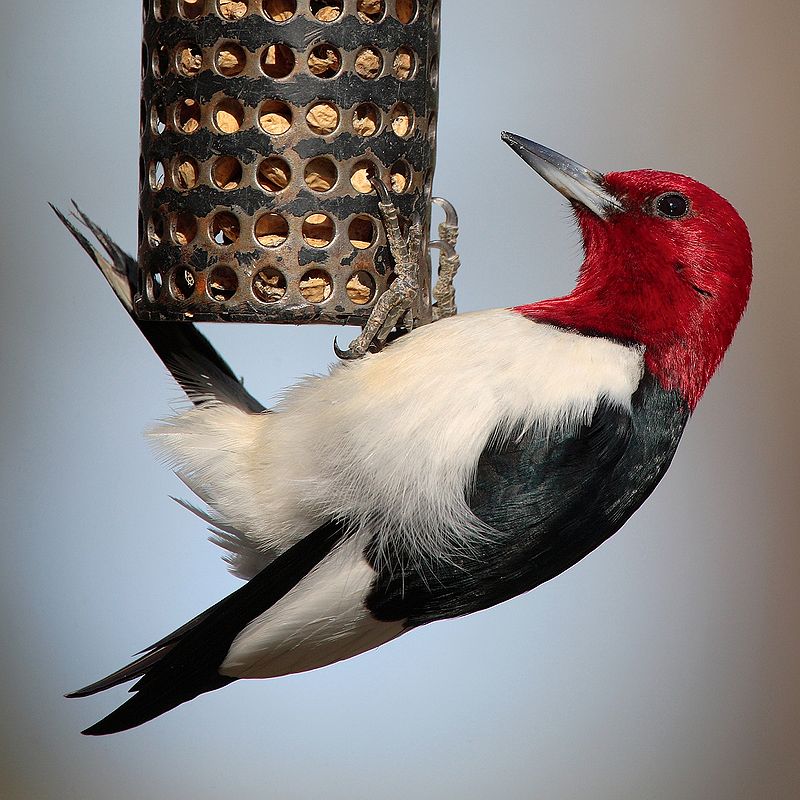
The red-headed woodpecker is a mid-sized bird found in temperate North America. It has striking plumage, with its head and neck bright red, while its body is primarily black and white.
Its wings are rounder than those of similar species, allowing it to maneuver through tight spaces effortlessly when searching for food or shelter.
The breeding habitat of this bird consists mainly of open fields across Canada and the east-central United States.
Despite facing threats such as deforestation, urbanization, predation from larger birds, and collisions with windows or cars due to their inquisitive nature.
These birds remain listed on IUCN’s Red List as the least concerned, thanks mainly to conservation efforts by local governments and organizations dedicated to protecting wildlife habitats.
Scientific classification:
| Kingdom | Animalia |
| Phylum | Chordata |
| Class | Aves |
| Order | Piciformes |
| Family | Picidae |
| Genus | Melanerpes |
| Species | M. erythrocephalus |
29. Purple Finch
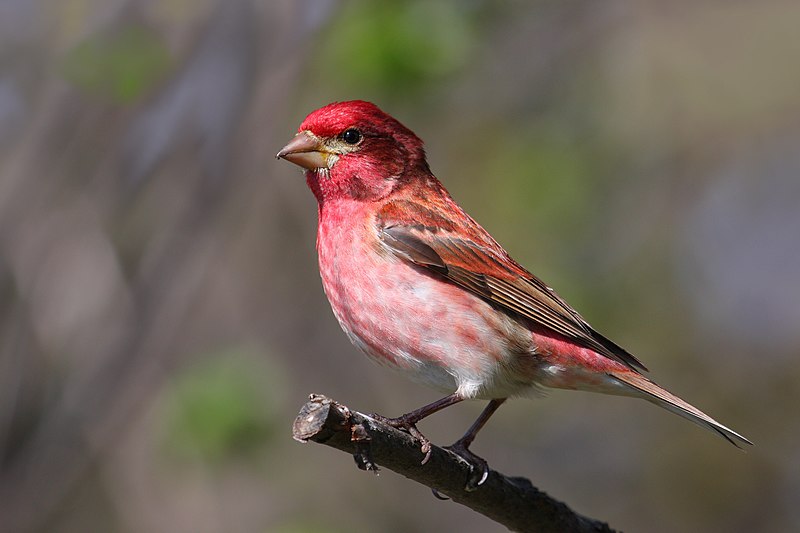
The Purple Finch is a species of finch from North America belonging to the Fringillidae family.
It’s also known as an “American Rosefinch” due to its resemblance in color and size to some European rosefinches.
Their plumage ranges from pinkish-purple on their heads and wings with a light brown underside.
Small birds measure about 5-6 inches long with short, thin beaks for eating seeds and insects.
In addition, they have thick, round bodies, which help them stay warm during cold winters in the northern parts of their range.
The Purple Finch has adapted well over time, making it easier for them to survive despite increasing threats posed by humans, such as deforestation or habitat destruction caused by development projects near their habitats.
Scientific classification:
| Kingdom | Animalia |
| Phylum | Chordata |
| Class | Aves |
| Order | Passeriformes |
| Family | Fringillidae |
| Subfamily | Carduelinae |
| Genus | Haemorhous |
| Species | H. purpureus |
30. American Crow
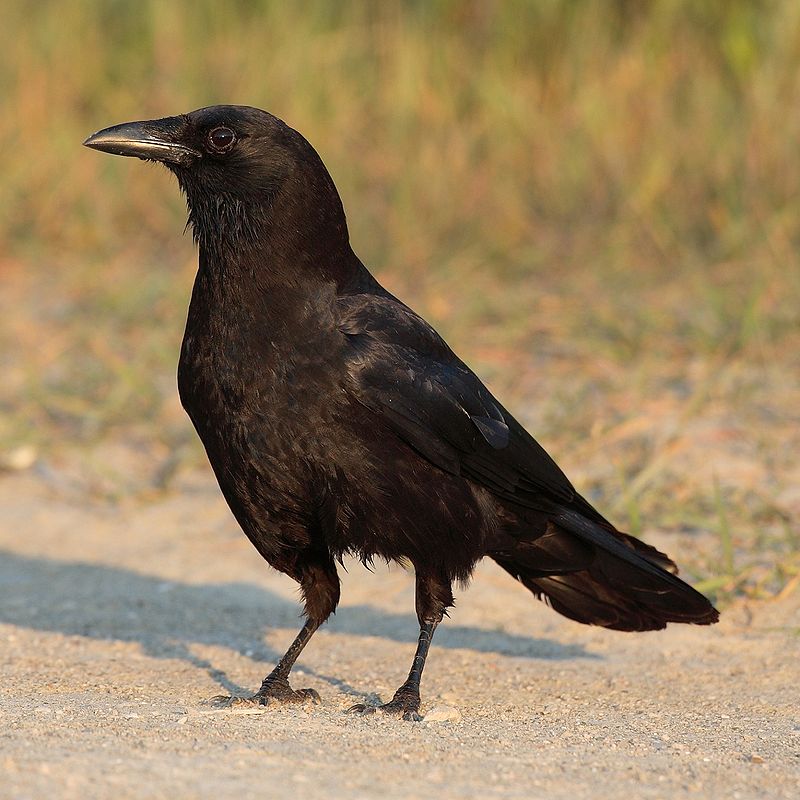
The American crow is a large bird of the Corvidae family, native to most parts of North America.
It is similar in size and structure to its European counterpart, the carrion crow and Eurasia’s hooded crow.
The three species occupy the same ecological niche but are distinguishable by their differences in appearance.
American crows have black feathers covering their entire body, with wingspans averaging between 17-21 inches wide for males and 16-19 inches for females.
They feed on insects such as grasshoppers, beetles, and caterpillars; they also eat grains from fields or abandoned farms during winter when food sources become scarcer.
In addition to feeding habits, American crows can be identified by their distinct call, which resembles a “caw” sound that travels long distances over open terrain, making them popular among birdwatchers.
Scientific classification:
| Kingdom | Animalia |
| Phylum | Chordata |
| Class | Aves |
| Order | Passeriformes |
| Family | Corvidae |
| Genus | Corvus |
| Species | C. brachyrhynchos |
31. Baltimore Oriole
The Baltimore Oriole is a small, blackbird-like bird in eastern North America. It’s named for the resemblance of its male colors to those on Lord Baltimore’s coat-of-arms from the 17th century.
These birds migrate and breed during springtime and are standard in their habitats.
Studies have shown that this species interbreeds with western Bullock’s orioles, classifying both as a single species – Icterus galbula.
The males typically have orange feathers along the chest, back, wings, and tail, while females display tan or yellowish shades instead of bright orange-like males.
Both sexes share white wing bars and dark brown eyes, making them easily distinguishable from other birds.
They can often be seen flitting around trees, feeding off nectar buds or insects such as grasshoppers & caterpillars they catch while flying around.
Scientific classification:
| Kingdom | Animalia |
| Phylum | Chordata |
| Class | Aves |
| Order | Passeriformes |
| Family | Icteridae |
| Genus | Icterus |
| Species | I. galbula |
32. Eastern Meadowlark
The Eastern meadowlark is a medium-sized blackbird found from eastern North America to northern South America.
It used to be considered the same species as the Western meadowlark but has since been separated into its distinct species.
The bird is mainly brown with yellow underparts and an orange patch on its throat; it also has white wing bars, which can be seen in flight.
Its song consists of a series of musical whistles followed by gurgling notes at the end, earning them their nickname “rainmaker” birds because they are believed to bring rain if heard singing during dry weather.
These beautiful birds feed primarily on insects, seeds, and other plant material while nesting amongst grasses or low shrubs near open fields where there’s plenty of food available for them.
Scientific classification:
| Kingdom | Animalia |
| Phylum | Chordata |
| Class | Aves |
| Order | Passeriformes |
| Family | Icteridae |
| Genus | Sturnella |
| Species | S. magna |
33. Chipping Sparrow
The Chipping Sparrow is a small passerine bird in most of North America. It has two subspecies, the eastern and western chipping sparrows, which migrate seasonally to overwinter in warmer climates.
The birds are grey above with white underparts, have a rufous cap with black stripes, and large eyes surrounded by light brown feathers.
They feed mainly on seeds but can also be seen eating insects during breeding season when raising their young chicks.
These brave little birds live in open grasslands such as prairies or meadows, building cup-shaped nests in trees or shrubs to raise their young family.
Their cheerful song often sounds like ‘chips,’ hence its name: Chipping Sparrow.
Scientific classification:
| Kingdom | Animalia |
| Phylum | Chordata |
| Class | Aves |
| Order | Passeriformes |
| Family | Passerellidae |
| Genus | Spizella |
| Species | S. passerina |
34. Summer Tanager
The Summer Tanager is a stunningly beautiful member of the cardinal family. Native to North and South America, this medium-sized songbird features striking red plumage on its back with yellow underparts.
It has a pointed black bill and long tail feathers that can be seen fluttering through the air when it flies.
The species’ vocalizations are similar to those of other members of its genus, often including short whistles and chirps and longer songs of various phrases or syllables.
With their vibrant colors and melodic voices, these birds make an eye-catching sight any time they appear.
Scientific classification:
| Kingdom | Animalia |
| Phylum | Chordata |
| Class | Aves |
| Order | Passeriformes |
| Family | Cardinalidae |
| Genus | Piranga |
| Species | P. rubra |
35. Brown Thrasher
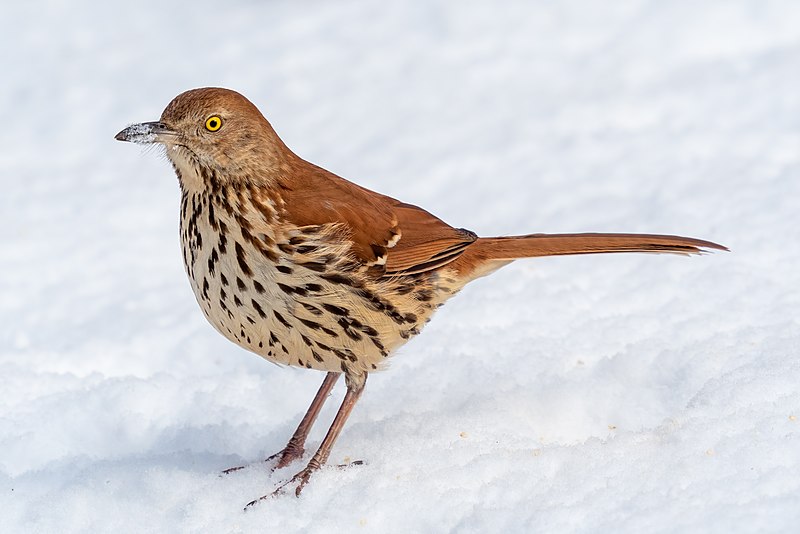
The brown thrasher is a member of the Mimidae family, along with catbirds and mockingbirds. It is found throughout much of North America in the eastern and central United States and southern and central Canada.
The only place it does not inhabit is west of the Rockies or Central Texas.
This bird can be identified by its reddish-brown back feathers, white underbelly, and long tail that often drags behind it when walking on the ground hunting for food like insects, fruits, or berries.
Its loud song consists of over 2000 different notes.
Brown Thrashers are known to build nests close to human activity, which makes them easily accessible for observation, making them a popular backyard species among many birdwatchers.
Scientific classification:
| Kingdom | Animalia |
| Phylum | Chordata |
| Class | Aves |
| Order | Passeriformes |
| Family | Mimidae |
| Genus | Toxostoma |
| Species | T. rufum |
36. Prairie Warbler
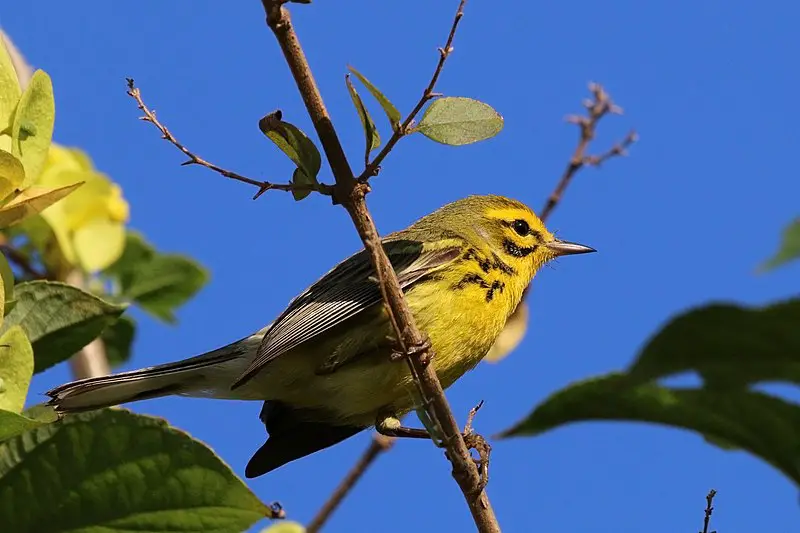
The Prairie Warbler is a small, colorful New World warbler family songbird. It has yellow underparts with dark streaks on its flanks and olive overparts with rusty streaks on its back.
Its head features a bright yellow line above the eye, contrasted by a darker line through it, and finished off with an additional bright yellow spot below.
This bird’s look is complete with black legs, long tails, two pale wing bars, and thin pointed bills.
In flight, they are known to have erratic movements while singing their distinctive loud “tweet” call as they pass overhead in migration or migrate between summer breeding grounds and wintering areas further south each year.
Scientific classification:
| Kingdom | Animalia |
| Phylum | Chordata |
| Class | Aves |
| Order | Passeriformes |
| Family | Parulidae |
| Genus | Setophaga |
| Species | S. discolor |
Also Featured In: Most Common Songs Birds that Live Around You, Common Birds of Prairie
37. Sandhill Crane
Sandhill Cranes are a large crane species native to North America and northeastern Siberia. They are known for their distinctive calls, long legs, and long necks.
These birds typically inhabit wetland areas like the Platte River in Nebraska’s Sandhills on the Great Plains.
In Central Florida, they often gather at the edges of bodies of water such as lakes or rivers.
During the breeding season, sandhill cranes can be seen performing elaborate courtship dances that involve bowing and jumping in unison with their partner.
Their diet consists mainly of plant material, including grains, roots, tubers, and aquatic plants, which they obtain by pecking or digging into mudflats using their bill or feet.
With an average lifespan of 10-20 years, these majestic creatures significantly add to any wetland habitat.
Scientific classification:
| Kingdom | Animalia |
| Phylum | Chordata |
| Class | Aves |
| Order | Gruiformes |
| Family | Gruidae |
| Genus | Antigone |
| Species | A. canadensis |
38. Eastern Phoebe
The Eastern Phoebe is a small passerine bird belonging to the genus Sayornis. It comes from Charles Lucien Bonaparte’s Muscicapa saya and Ancient Greek ornis, meaning “bird.”
The species’ alternative name ‘Phoebe’ comes from the Roman moon goddess Diana but has also been said to imitate their call.
They are up to 16 cm long with a 25–30 cm wingspan; they have grayish brown upperparts and pale underparts.
They are found near streams, woodlands, and open fields where they hunt for insects such as flies, bees, wasps, etc., often catching them midair or by sallying out from perches like branches or fences.
These birds make shallow cup nests of grasses lined with mud-built on cliffs, ledges, buildings, bridges, trees, etc.
This beautiful little bird is an exciting addition wherever you find it.
Scientific classification:
| Kingdom | Animalia |
| Phylum | Chordata |
| Class | Aves |
| Order | Passeriformes |
| Family | Tyrannidae |
| Genus | Sayornis |
| Species | S. phoebe |
39. Northern Parula
The Northern Parula is a small, migratory warbler native to North America. It measures 4.3 and 4.9 inches long and has a wingspan of 6.3-7.1 inches wide.
Its plumage consists mainly of yellowish-green upperparts with an orange patch on its chest and blue crowns for males during the breeding season.
Females have duller colors than their male counterparts overall but are still quite striking from afar.
This species breeds primarily in eastern Canada down through Florida. However, some northern populations may migrate southward come wintertime. In contrast, others stick around year-round depending on the weather conditions each year – genuinely unique adaptability sets them apart from other birds in this region.
Scientific classification:
| Kingdom | Animalia |
| Phylum | Chordata |
| Class | Aves |
| Order | Passeriformes |
| Family | Parulidae |
| Genus | Setophaga |
| Species | S. americana |
40. House Wren
The House Wren is a small bird of the Wren family found in Canada and South America. It’s pretty standard in suburban areas and is one of the most widely distributed native birds in North and South America.
Its taxonomy can be complicated, with some subspecies groups considered separate species.
The House Wren has a brown back, grey head, white eyebrow stripes, light chestnut belly, and buffy flanks.
They often inhabit old or abandoned buildings and shrublands near fields or open woods for nesting sites.
During the breeding season, they are highly territorial, so create an inviting environment to invite them into your yard.
Scientific classification:
| Kingdom | Animalia |
| Phylum | Chordata |
| Class | Aves |
| Order | Passeriformes |
| Family | Troglodytidae |
| Genus | Troglodytes |
| Species | T. aedon |
41. Loggerhead Shrike
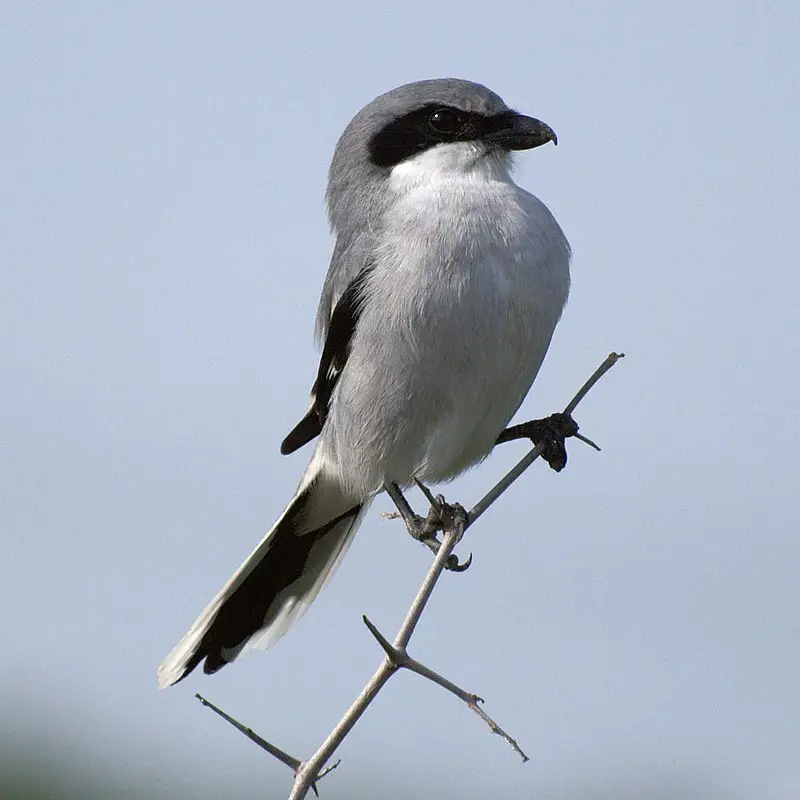
The Loggerhead Shrike is a carnivorous bird found only in North America. It belongs to the family Laniidae and is known as the “butcherbird” because of its habit of catching prey, such as amphibians, insects, lizards, and small mammals.
The shrike has a black mask around its eyes and grey wings with white patches on them.
Its back is black with white spots resembling stars or snowflakes; some may have brown feathers instead of black ones.
This species feeds mainly by perching from elevated locations like bushes or trees where it can spot potential meals below it before diving down for capture.
Interestingly, these birds are also known to store their food by impaling it onto thorns, which they use later when hungry.
With an estimated population of less than 2 million in the wild today, this species needs our help, so we should do whatever we can to protect them better.
Scientific classification:
| Kingdom | Animalia |
| Phylum | Chordata |
| Class | Aves |
| Order | Passeriformes |
| Family | Laniidae |
| Genus | Lanius |
| Species | L. ludovicianus |
42. Orchard Oriole
The Orchard Oriole is a small species of icterid bird, with the subspecies I. s. Fuerte is sometimes considered a separate species known as the Ochre or Fuertes’ Oriole.
The adult male of the nominate subspecies has chestnut upperparts and black wings and tail, while females are more yellowish-green in coloration on their back and wings.
Its bill is pointed and black, with some blue-gray at the base of its lower mandible.
This beautiful bird can also be found across North America during migration season; they inhabit woodlands near streams or rivers to breed before migrating south for winter months.
Scientific classification:
| Kingdom | Animalia |
| Phylum | Chordata |
| Class | Aves |
| Order | Passeriformes |
| Family | Icteridae |
| Genus | Icterus |
| Species | I. spurius |
43. Cooper’s Hawk
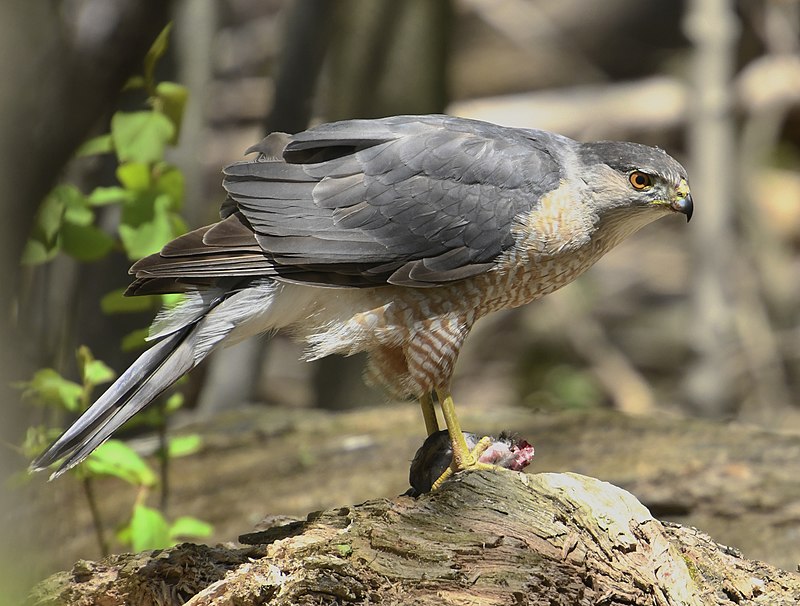
Cooper’s Hawk is a medium-sized bird of prey native to North America. It belongs to the Accipiter genus and is known for its agility and small size compared to other hawks.
They usually inhabit wooded areas, making them well-adapted hunters in dense environments.
Cooper’s Hawks have rounded wings with short tails that help them maneuver quickly through trees when chasing after prey, such as small rodents or birds.
These raptors also possess powerful feet equipped with sharp talons to catch food items on the ground and even out of midair.
The adult plumage has barred upperparts, ranging from greyish brown on lighter individuals to dark chestnut colors found in darker specimens; they also display rusty underparts marked by thin white streaking down either side of their chests and bellies.
Scientific classification:
| Kingdom | Animalia |
| Phylum | Chordata |
| Class | Aves |
| Order | Accipitriformes |
| Family | Accipitridae |
| Genus | Accipiter |
| Species | A. cooperii |
44. Red-Tailed Hawk
The Red-tailed Hawk is a majestic bird of prey with a distinctive red tail. It can be found throughout North America, from Alaska in the north to Panama and the West Indies in the south.
This species belongs to the Buteo genus, making it one of Earth’s most common raptorsarth.
These hawks mainly hunt small mammals such as rabbits or squirrels but also feed on reptiles and birds during migration season.
Unlike other predator birds, they prefer open areas for hunting, like fields or grasslands, rather than dense forests.
They build their nests high on trees, staying all year long unless humans or animals nearby disturb them.
Their presence has become an iconic part of American culture due to their frequent sightings around homes and parks alike, making them beloved creatures among people everywhere.
Scientific classification:
| Kingdom | Animalia |
| Phylum | Chordata |
| Class | Aves |
| Order | Accipitriformes |
| Family | Accipitridae |
| Genus | Buteo |
| Species | B. jamaicensis |
45. Yellow-Throated Warbler
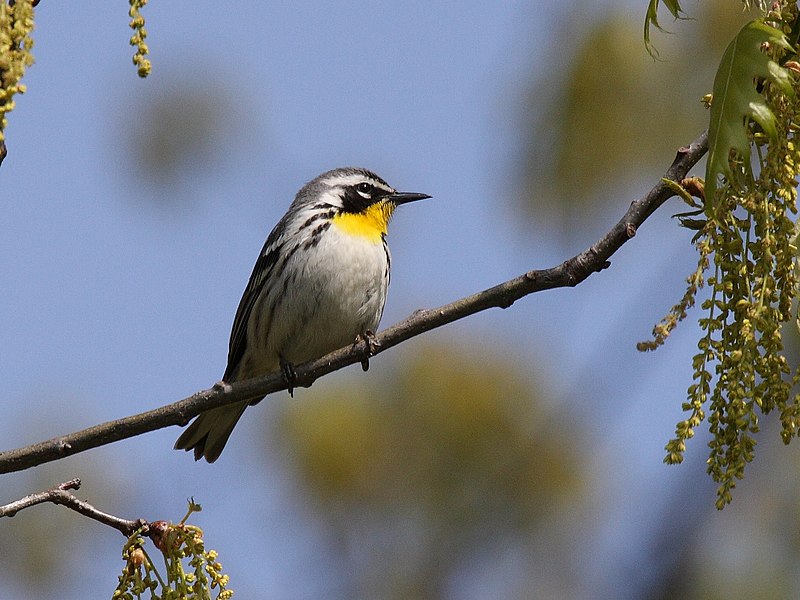
The Yellow-throated Warbler (Setophaga dominica) is a small migratory songbird in temperate North America. It belongs to the Parulidae family of New World warblers.
Males have grey upperparts and wings with double white wing bars, yellow throats, and white underparts streaked with black on the flanks.
Females are less brightly colored, having olive green or brownish gray back and wings with two faint wing bars instead of one bright one visible in males.
These birds feed mainly on insects during their breeding season but will also eat fruits at other times of the year while they migrate southwards for wintering grounds, where they will search for nectar from flowers and fruit sources such as berries and wild grapes.
They can be seen actively searching through trees for food items near bird feeders during migration, making them an exciting species to observe.
Scientific classification:
| Kingdom | Animalia |
| Phylum | Chordata |
| Class | Aves |
| Order | Passeriformes |
| Family | Parulidae |
| Genus | Setophaga |
| Species | S. dominica |
46. Evening Grosbeak
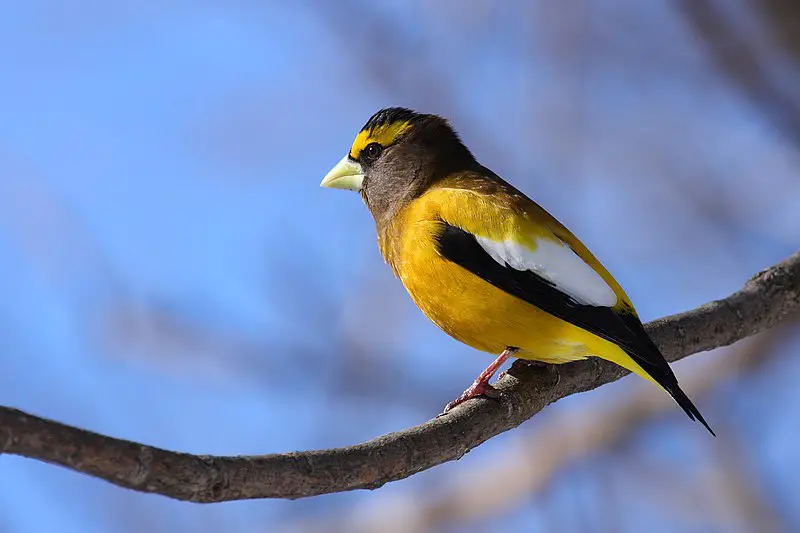
The evening grosbeak (Hesperiphona vespertina) is a beautiful passerine bird in the finch Fringillidae, native to North America.
It has an impressive wingspan of up to 20 inches, and its plumage is mostly black, yellow, or grey, with distinctive white patches on each side of its head.
Its diet consists mainly of seeds, other plant matter, and small insects, fruit, and berries when available.
The male’s song is loud and melodic, which can be heard from some distance away during breeding season, making it a widespread species for avid backyard birders.
The Evening Grosbeak typically nests high in coniferous trees, building cup-shaped structures lined with feathers or grass that protect against predators.
Overall, this species makes an excellent addition to any backyard aquarium.
Scientific classification:
| Kingdom | Animalia |
| Phylum | Chordata |
| Class | Aves |
| Order | Passeriformes |
| Family | Fringillidae |
| Subfamily | Carduelinae |
| Genus | Hesperiphona |
| Species | H. vespertina |
47. Eastern Wood-Pewee
The Eastern Wood-Pewee (Contopus virens) is an iconic bird of North America, easily identified by its distinctive call.
It was formerly considered a single species with the Western Wood-Pewee until Mathurin Jacques Brisson included it in his 1760 description as two distinct birds.
The Eastern and Western varieties share almost identical appearances. Still, they can be differentiated most clearly through their calls – the former’s being more musical with higher pitched notes than its counterpart.
Its diet consists mainly of insects caught mid-flight or from foliage perches; however, it will also consume some fruits during the breeding season to supplement this nutrition.
Overall, they make a beautiful addition to any backyard habitat.
Scientific classification:
| Kingdom | Animalia |
| Phylum | Chordata |
| Class | Aves |
| Order | Passeriformes |
| Family | Tyrannidae |
| Genus | Contopus |
| Species | C. virens |
48. Northern Goshawk
The Northern Goshawk is a medium-large bird of prey belonging to the Accipitridae family. It has been known as one of the true hawks, with “Accipiter” meaning Hawk in Latin and “gentiles” referring to its noble characteristics.
They are found worldwide, most commonly in wooded areas such as forests or thickets, where they hunt small birds and mammals.
The males have spotted grey upperparts, while females tend to be entirely brown above with some lighter barring on their underparts.
These raptors rely heavily on speed and agility when hunting from perches or during aerial dives at high speeds for their prey, making them formidable predators that can reach up to 40 miles per hour.
Scientific classification:
| Kingdom | Animalia |
| Phylum | Chordata |
| Class | Aves |
| Order | Accipitriformes |
| Family | Accipitridae |
| Genus | Accipiter |
| Species | A. gentilis |
Conclusion
Kentucky’s rich birdlife showcases its diverse ecosystems, from woodlands to wetlands. While this list features 48 notable species, it’s just a glimpse into the avian diversity of Bluegrass State.
Each bird plays a vital role in the local ecology and contributes to Kentucky’s natural beauty. Protecting these birds and their habitats is crucial for maintaining the ecological balance and preserving Kentucky’s unique avian heritage.